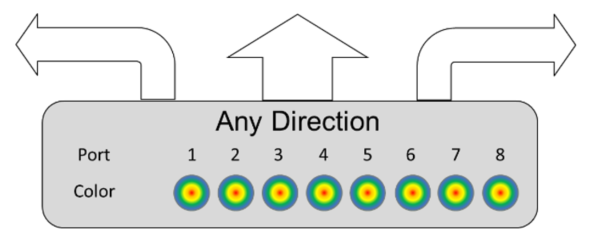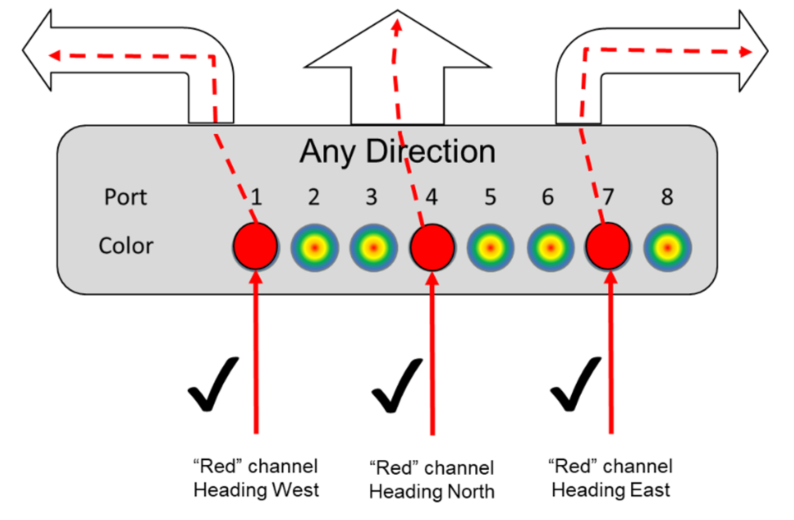The ROADM Tutorial Blogs, part 4

In this series of tutorials I explain the key functionality (and their benefits) that underpin next-generation ROADM: Colorless, Directionless, Contentionless, and Gridless (CDC-G) functionality.
In this blog, I explain the second “C” – Contentionless – and the operational benefits it provides.
Previous ROADMs were Contentionless
First, let’s define contentionless. A ROADM is contentionless if it is possible to simultaneously add/drop the same wavelength (or color) in different directions. This might come as a bit of a surprise, but fixed mux/demux legacy ROADMs were contentionless. Let’s reuse the diagram we used in a prior blog to explain how:

Let’s assume we want to insert a red wavelength in the West direction and one in the North direction. This is possible using a legacy ROADM. One transponder is connected to the West mux/demux and another transponder is connected to the North mux/demux.
The red wavelength can be added to every direction using separate transponders and these wavelengths can be kept physically separate.
Next Generation ROADM & Contention
As we introduced Directionless ROADM, we have collapsed the add/drop complex into a single device, which provides access to all ROADM degrees as depicted in the figure below from the Directionless blog.

One consequence of the Directionless ROADM is that the add/drop complex is a single point where all the add/drop wavelengths are present. As a result, any color (wavelength) can only be used once, and be routed in a single direction within a single add/drop complex.
For example, if a service provider adds a red wavelength in the West direction, then, a red wavelength cannot be added to any other direction from that directionless module. This can lead to wavelength blocking scenarios – or contention.

There are a few ways to address this blocking issue and the most common are:
- Accept the limitation. In cases where the wavelength count is low and the number of ROADM degrees is low, such as spur and ring sites, the likelihood of facing a blocking issue is low and a simple directionless architecture is sufficient and more cost effective.
- Support multiple directionless add/drop modules at a site. This is the approach Fujitsu selected for the 1FINITY L100 CD ROADM. The directionless add/drop module supports 16 wavelengths per module and this wavelength blocking only applies within the individual add/drop modules.
- Use an add/drop module with contentionless support as described in the next section.
Contentionless ROADMs
A contentionless ROADM, typically referred to as CDC-G, provides a single add/drop complex with colorless, directionless and gridless functionality and the ability to add and drop multiple instances of the same wavelength, or color, on the same drop complex as shown below.

The contentionless nature of the add/drop complex allows the “coexistence” of multiple instances of the same color. The only limitation is the fact that each instance of the same color has to be routed to different directions.
Flexibility vs. Overall Cost
Full CDC-G ROADMs obviously provide the maximum amount of flexibility. The ROADM is fully colorless, directionless, contentionless, and gridless, and there is no risk of wavelength blocking.
This flexibility typically comes at a cost. CDC-G solutions are more expensive and in some cases, their architecture require higher amplification levels leading to lower optical reachability.
Recognizing this fact, Fujitsu believes that service providers should have the ability to choose between a full CDC-G implementation and a CD-G architecture suitable where the risk of contention is lower. Both solutions can be selected on a per site basis and they have the ability to coexist within the same network. This means that ROADM networks can be “right-sized” according to the functionality required, and over-engineering can be avoided. “Contentionless” functionality is supported on the 1FINITY L130, L220 and L140 ROADM blades. This feature is particularly suitable for large ROADM hub sites where the high number of degrees and the large number of transponders increases the likelihood of contention.